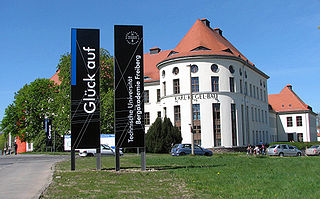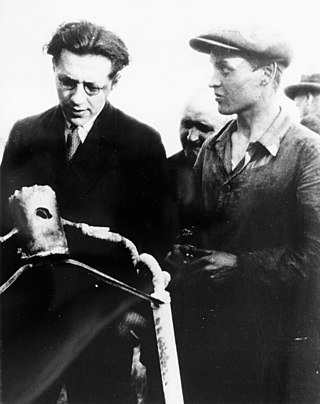Biography
His father, Karl, was the station master in Sorau. During his years in primary and secondary school there, he was already involved in technical projects at the railway workshop. After an accident that shattered one of his legs, he was sent to a gymnasium in Frankfurt an der Oder.
After starting an apprenticeship as a watchmaker, he switched to being a mechanic and worked in Berlin. There, he designed and made his own shuttle sewing machine and lathe. After completing that apprenticeship, he was employed as a precision mechanic for "Pistor & Martins", a company that made surveying and measuring tools. Later, he worked for them in Paris and represented the company at the Exposition Universelle (1867).
The following year, he joined an expedition to Siam to observe a solar eclipse. After gaining more professional experience in England, he returned to Berlin and set up his own workshop. There, he did work for the Berlin Observatory, the Imperial Standard Calibration Commission and the German General Staff.
In 1873, he moved to Freiberg, where he became a partner in the precision engineering workshop, "August Lingke & Compagnie", which would later become "Hildebrand & Schramm". He also took part in the discussions between the Generals Helmuth von Moltke and Otto von Morozowicz [ de ] with the Director of the observatory, Wilhelm Foerster; talks which would lead to the establishment of the Physikalisch-Technische Bundesanstalt. In 1895, he was appointed a member of that organization's Board of Trustees.
He was especially interested in equipment for mine surveying. In 1876, he developed a device for setting up a theodolite and target signs underground. He also devised a way to make optical plumb bobs. From 1883 to 1892, his workshop introduced improvements to levels, compasses and theodolites.
In 1909, the Freiberg University of Mining and Technology and the Technische Universität Dresden joined to present him with an honorary Doktoringenieur degree.
His brother was the painter, Ernst Hildebrand. He was married to Maria Ockel (1842–1908). Their daughter, Charlotte (1880–1953), married the Bergbeamter [ de ] (mining official) Karl Spitzner [ de ].

Freiberg is a university and former mining town in Saxony, Germany. It is a so-called Große Kreisstadt and the administrative centre of Mittelsachsen district.

The Physikalisch-Technische Bundesanstalt (PTB) is the national metrology institute of the Federal Republic of Germany, with scientific and technical service tasks. It is a higher federal authority and a public-law institution directly under federal government control, without legal capacity, under the auspices of the Federal Ministry for Economic Affairs and Energy.

Troughton & Simms was a British scientific instrument firm. It was formed when Edward Troughton in his old age took on William Simms as a partner in 1826. It became a limited company in 1915 and in 1922 it merged with T. Cooke & Sons to form Cooke, Troughton & Simms.

The Technische Universität Bergakademie Freiberg is a public university of technology with currently 3655 students in the city of Freiberg, Saxony, Germany. Its focuses are on exploration, mining & extraction, processing, and recycling of natural resources & scrap, as well as developing new materials. Today, it's the oldest university of mining and metallurgy in the world.
Ernst J. L. Gehrcke was a German experimental physicist. He was director of the optical department at the Reich Physical and Technical Institute. Concurrently, he was a professor at the University of Berlin. He developed the Lummer–Gehrcke method in interferometry and the multiplex interferometric spectroscope for precision resolution of spectral-line structures. As an anti-relativist, he was a speaker at an event organized in 1920 by the Working Society of German Scientists. He sat on the board of trustees of the Potsdam Astrophysical Observatory. After World War II, he worked at Carl Zeiss Jena, and he helped to develop and become the director of the Institute for Physiological Optics at the University of Jena. In 1949, he began work at the German Office for Materials and Product Testing. In 1953, he became the director of the optical department of the German Office for Weights and Measures.

The Berlin Observatory is a German astronomical institution with a series of observatories and related organizations in and around the city of Berlin in Germany, starting from the 18th century. It has its origins in 1700 when Gottfried Leibniz initiated the "Brandenburg Society of Science″ which would later (1744) become the Prussian Academy of Sciences. The Society had no observatory but nevertheless an astronomer, Gottfried Kirch, who observed from a private observatory in Berlin. A first small observatory was furnished in 1711, financing itself by calendrical computations.

Friedrich Drake was a German sculptor,and medallist, best known for his huge memorial statues.
The Gottfried Wilhelm Leibniz Prize, in short Leibniz Prize, is awarded by the German Research Foundation to "exceptional scientists and academics for their outstanding achievements in the field of research". Since 1986, up to ten prizes are awarded annually to individuals or research groups working at a research institution in Germany or at a German research institution abroad. It is considered the most important research award in Germany.

The Clausthal University of Technology is an institute of technology in Clausthal-Zellerfeld, Lower Saxony, Germany. The small public university is regularly ranked among the Top German universities in engineering by CHE University Rankings. More than 30% of students and 20% of academic staff come from abroad, making it one of the most international universities in Germany. The university is best known for the prominent corporate leaders among its former students. In 2011, five of the 30 leading companies within the German stock index had alumni of TUC on their management board. Two of them as CEO.

Karl August Lossen was a German petrologist and geologist.

Werner Hartmann was a German physicist who introduced microelectronics into East Germany. He studied physics at the Technische Hochschule Berlin and worked at Siemens before joining Fernseh GmbH. At the end of World War II, he and his research staff were flown to the Soviet Union to work on their atomic bomb project; he was assigned to Institute G. In 1955, he arrived in the German Democratic Republic (GDR); in the same year, he founded and became the director of the VEB Vakutronik Dresden, later VEB RFT Meßelektronik Dresden. In 1956, he completed his Habilitation at the Technische Hochschule Dresden and also became a professor for Kernphysikalische Elektronik there. In 1961, he founded the Arbeitsstelle für Molekularelektronik Dresden (AME). He was awarded the National Prize of GDR in 1958. In 1974, he was removed from his positions, significantly demoted, and sent to work as a staff scientist at the VEB Spurenmetalle Freiberg. Hartmann had been the object of security investigations by the Stasi for some time; while he was investigated at length and repeatedly interrogated, the alleged charges were politically motivated and no trial ever took place. The Werner-Hartmann-Preis für Chipdesign is an industrial award given in Hartmann's honor for achievement in the field of semiconductors.
Eberhard Wächtler was a German economic historian. He was particularly notable for research in coal and steel sciences in postwar Germany.

Dagmar Hülsenberg is a German materials scientist and university professor.
Helmut Kirchberg was a German mining scientist. In 1953 he was appointed Rector of the Freiberg University of Mining and Technology.
Karl Friedrich Schall was a German precision engineer and co-founder of the company Reiniger, Gebbert & Schall (RGS) in Erlangen. RGS was a manufacturer and supplier of durable medical equipment and a pioneer in the supply of x-ray equipment worldwide with offices in Berlin, Wien, London, Paris, Rome, Chicago and Sydney.

Herta Hammersbacher (2 December 1900 in Nuremberg – 25 May 1985 in Niederpöcking near Starnberg) was a German landscape architect who taught for more than 20 years at the TU Berlin.

Bekenntnis der Professoren an den Universitäten und Hochschulen zu Adolf Hitler und dem nationalsozialistischen Staat officially translated into English as the Vow of allegiance of the Professors of the German Universities and High-Schools to Adolf Hitler and the National Socialistic State was a document presented on 11 November 1933 at the Albert Hall in Leipzig. It had statements in German, English, Italian, and Spanish by selected German academics and included an appendix of signatories. The purge to remove academics and civil servants with Jewish ancestry began with a law being passed on 7 April 1933. This document was signed by those that remained in support of Nazi Germany.

Paul Ehmayr was a German-Austrian rocket engineer. He was a precision mechanic. His masterpiece was a barometer.
Jean Brunner or Johann Josef Brunner, was a Swiss-born, French measuring instrument maker and mechanic.

Henri-Prudence Gambey was French mechanic and scientific instrument maker. His precision instruments made mainly for survey, geomagnetism, and astronomy were used around the world in the early 19th century.















